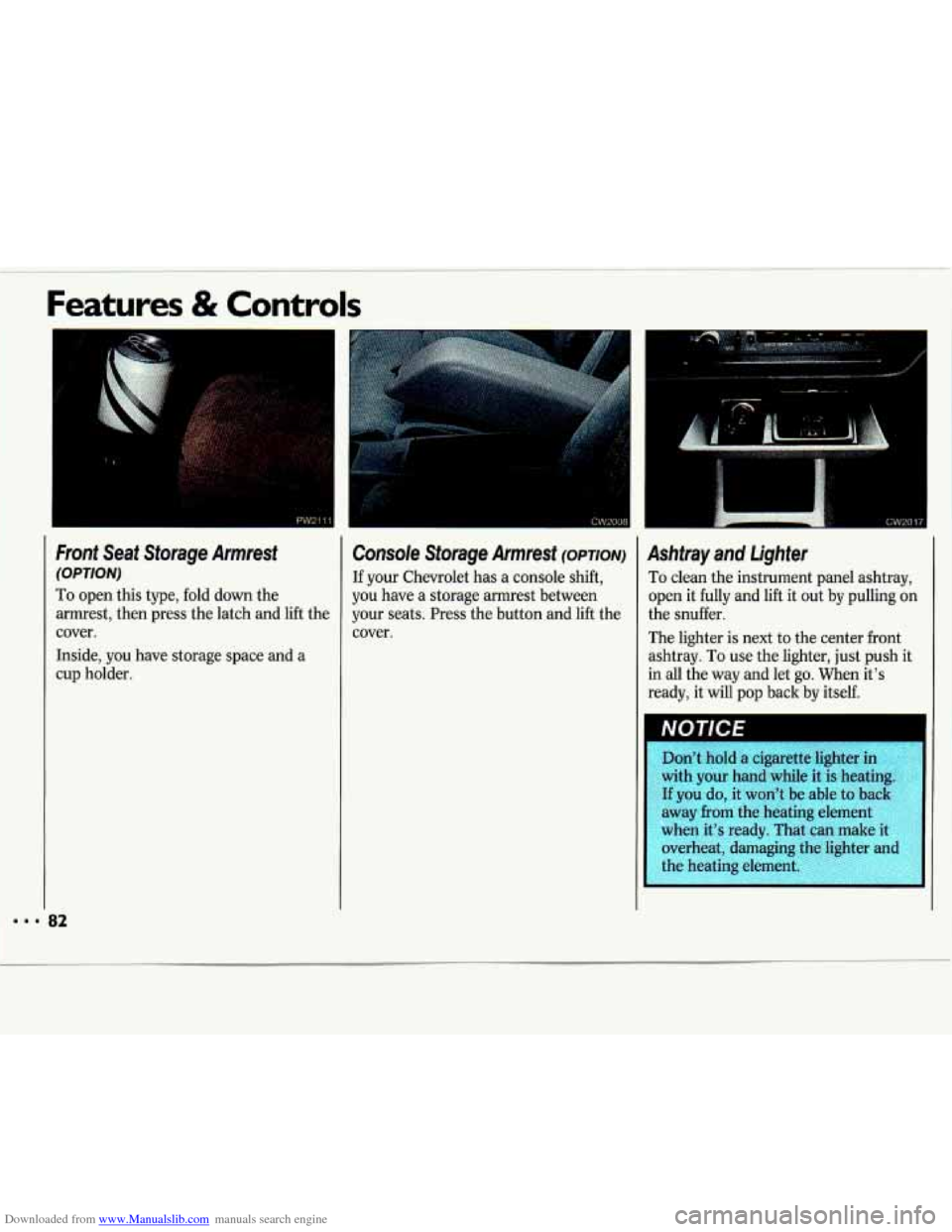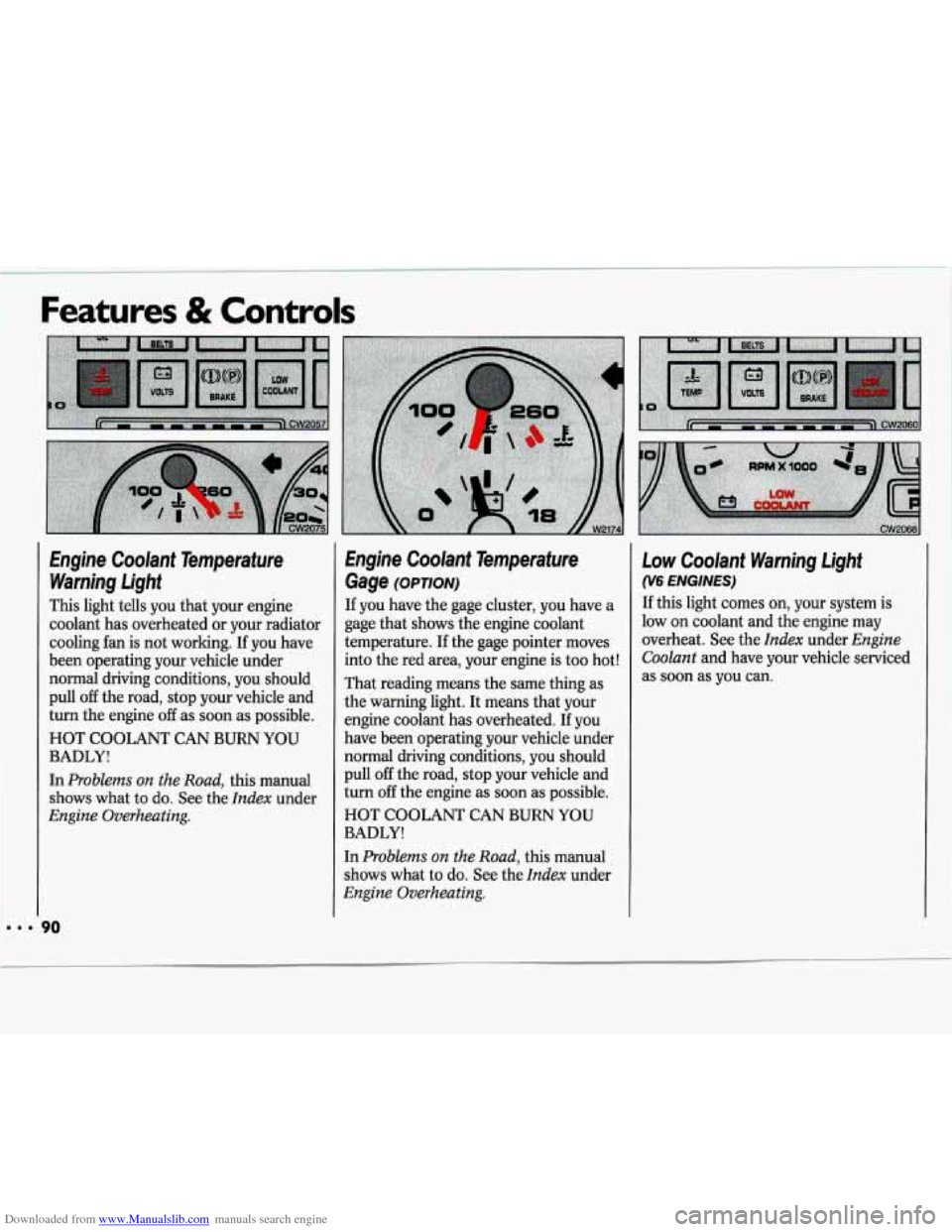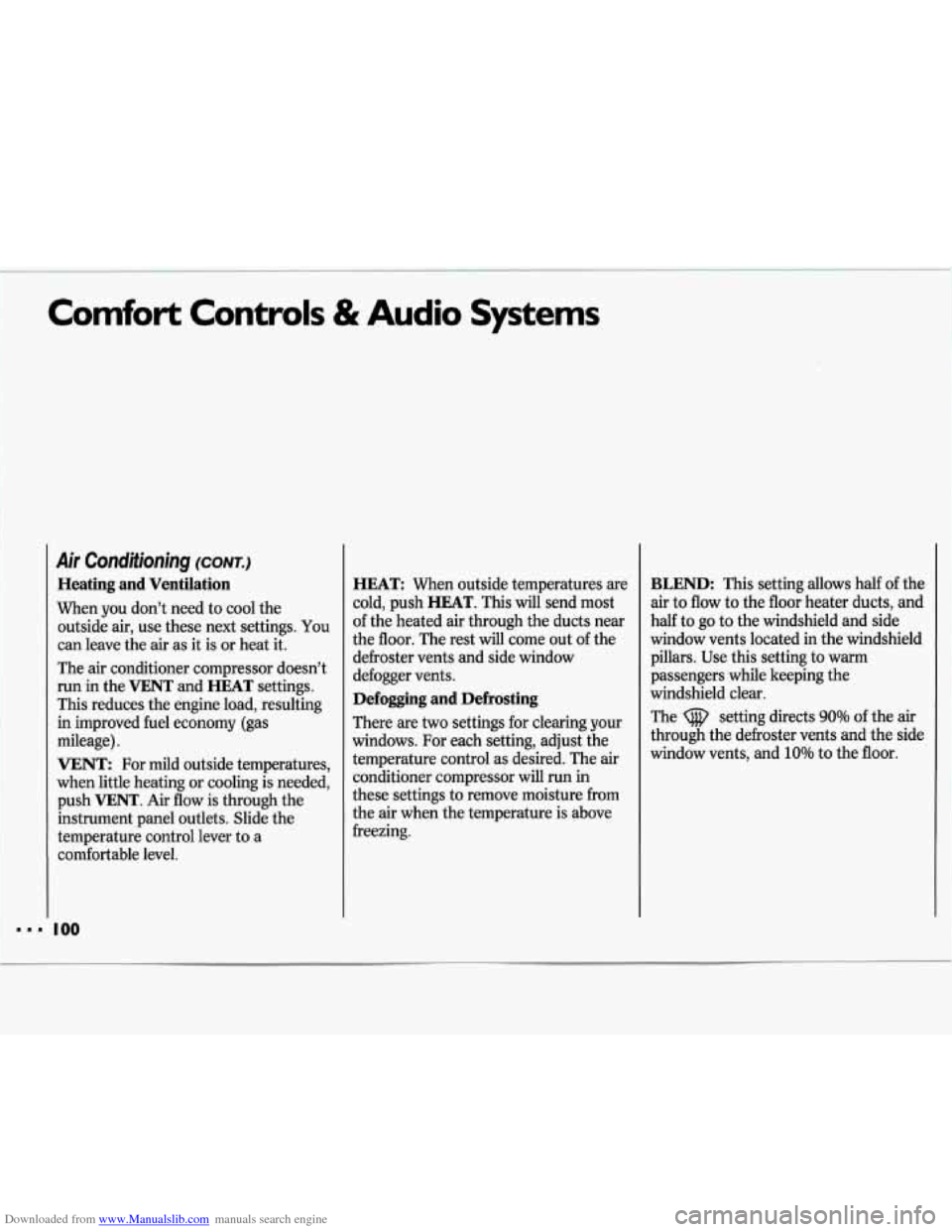1993 CHEVROLET LUMINA heating
[x] Cancel search: heatingPage 8 of 324

Downloaded from www.Manualslib.com manuals search engine How to Use this Manual
', !. -7 ': ,
Using Your 1993 Chevrolet
Owner's Manual
Many people read their owner's manual
from beginning to end when they first
receive their new vehicle. This will help
you learn about the features and
controls for your vehicle. In this
manual, you'll find that pictures and
words work together to explain things
quickly.
There are nine parts with color-tabbed pages in this manual. Each part begins
with a brief list of contents,
so you can
usually tell at a glance
if that part
contains the information you want.
You can bend the manual slightly to
reveal the color tabs that help you find a
part.
6
Part 1: Seats and Safety Belts
This part tells you how to use your seats
and safety belts properly.
Part 2: Features & Controls
This part explains how to start and
operate your Chevrolet.
Part 3: Comfort Controls & Audio
Systems
This part tells you how to adjust the
ventilation and comfort controls and
how
to operate your audio system.
Part 4: Your Driving and the Road
Here you'll find helpful information and
tips about the road and how to drive
under different conditions.
Part 5: Problems on the Road
This part tells you what to do if you
have a problem while driving, such as a
flat tire or engine overheating.
Part 6: Service & Appearance Care
Here the manual tells you how to keep
your Chevrolet running properly and looking good.
Part 7: Maintenance Schedule
This part tells you when to perform
vehicle maintenance and what fluids and lubricants to use.
Part 8: Customer Assistance
Information
This part tells you how to contact
Chevrolet for assistance and how to get
service publications. It also gives you
information on
Reporting Safety Defects.
Part 9: Index
Here's an alphabetical listing of almost
every subject in this manual. You can
use it to quickly find something you
want to read.
Service Station Information
This is a quick reference of service
information. You can find it on the last
page of this manual.
Page 82 of 324

Downloaded from www.Manualslib.com manuals search engine Features & Controls
Courtesy and Instrument Panel
Lights (CONT.)
When you close a door (or the last door
when more than one are open at the
same time), other lights will come on.
They are in your instrument panel and
the switches for your doors, headlamps,
radio, heating and air conditioning
systems
(if equipped).
These lights will go
off automatically
after about
30 seconds.
L
".. .
Inside Manual DaylNighf
Rearview Mirror
To reduce glare from lights behind you,
pull the lever toward
you to the night
position.
Convex Outside Mirror
Your right side mirror is convex. A
convex mirror's surface is curved so you
can see more from the driver's seat.
1 CAUTIVN
I
If you aren't used to a convex
mirror, you can hit another
vehicle. A convex mirror can make
things (like other vehicles) look
farther away than they redly are. If
you cut too sharply into the right
lane, you could hit a vehicle on
youi right. Check your inside
mirror
or glance over your shoulder II
before changing lanes.
Page 84 of 324

Downloaded from www.Manualslib.com manuals search engine Front Seat Storage Armrest
(OPTION)
To open this type, fold down the
armrest, then press the latch and lift the
cover.
Inside, you have storage space and a
cup holder.
I cw2oue
Console Storage Armrest (OPTION) I Ashtray and Lighter
If your Chewolet has a console shift,
you have
a storage armrest between
your seats. Press the button and lift the
cover.
CW2017 -
To clean the instrument panel ashtray,
open it fully and lift it out by pulling
on
the snuffer.
The lighter
is next to the center front
ashtray.
To use the lighter, just push it
in all the way and let go. When it’s
ready, it will pop back by itself.
Don’t hold a cigarette lighter in
with your hand while it is heating.
If you do, it won’t be able to back
away from the heating element
when it’s ready. That
can make it
overheat, damaging the lighter
and
the heating element.
Page 92 of 324

Downloaded from www.Manualslib.com manuals search engine Features & Controls
Engine Coolant Temperature Warning Light
This light tells you that your engine
coolant has overheated or your radiator
cooling fan is not working. If you have
been operating your vehicle under normal driving conditions, you should
pull
off the road, stop your vehicle and
turn the engine
off as soon as possible.
HOT COOLANT CAN BURN YOU
BADLY!
In
Problems on the Road, this manual
shows what to
do. See the Index under
Engine Overheating.
Engine Coolant Temperature
Gage
(OPTION)
If you have the gage cluster, you have a
gage that shows the engine coolant
temperature. If the gage pointer moves
into the red area, your engine is too hot!
That reading means the same thing as
the warning light. It means that your
engine coolant has overheated. If you
have been operating your vehicle under
normal driving conditions, you should
pull
off the road, stop your vehicle and
turn off the engine as soon as possible.
HOT COOLANT CAN BURN
YOU
BADLY!
In
Problems on the Road, this manual
shows what to do. See the
Index under
Engine Overheating.
Low Coolant Warning Light
(v6 ENGINES)
If this light comes on, your system is
low on coolant and the engine may
overheat. See the
Index under Engine
Coolant and have your vehicle serviced
as soon as you can.
Page 100 of 324

Downloaded from www.Manualslib.com manuals search engine Comfort Controls & Audio Systems
Heater Controls
OFF: Press to turn the system off.
Some air will still come from the
outlets at the floor. Press any function
button to turn the system on.
Temperature Control Lever: This
lever changes the temperature
of the
air coming through the system. The
farther the lever is to the right, the
warmer the air.
8: Selects the force of air you want.
Press
V to lower the fan speed, A to
raise it.
Heating and Ventilation
There are three settings to heat and
ventilate your vehicle. For each setting,
set the temperature control lever to a
comfortable setting.
HEAT: Press to direct heated air
through the heater ducts. Some heated
air will also come through the
windshield defroster vents.
BI-LEV: Use on cool, but sunny days.
This setting brings in the outside air,
but directs it in two ways. The cool air is directed to the upper portion of your
body through the instrument panel
outlets, but most warmed air is directed
through the heater ducts and
a little to
the defrost and side window vents. At
times this temperature difference may
be more apparent than others.
VENT: Press to direct air through the
instrument panel outlets. Useful when
outside temperatures are mild and little
heating is necessary.
Defogging and Defrosting
There are two settings for clearing your
windows. For each setting, set the
temperature control lever to a
comfortable setting.
BLEND: Press to direct air through
the floor vents and windshield vents
equally. Useful when you need defrosting but want to keep the
passenger compartment warm, too.
cifi, (Defrost): Press to direct air
through the windshield defroster vents
and vents near the side windows. Some
air will also come through the heater
ducts.
Page 102 of 324

Downloaded from www.Manualslib.com manuals search engine Comfort Controls & Audio Systems
Air Conditioning (CONT.)
Heating and Ventilation
When you don’t need to cool the
outside air, use these next settings.
You
can leave the air as it is or heat it.
The air conditioner compressor doesn’t
run in the
VENT and HEAT settings.
This reduces the engine load, resulting
in improved fuel economy (gas
mileage).
VENT: For mild outside temperatures,
when little heating or cooling is needed,
push
VENT. Air flow is through the
instrument panel outlets. Slide the
temperature control lever to a
comfortable level.
HEAT When outside temperatures are
cold, push
HEAT. This will send most
of the heated air through the ducts near
the floor. The rest will come out of the
defroster vents and side window
defogger vents.
Defogging and Defrosting
There are two settings for clearing your
windows. For each setting, adjust the
temperature control as desired. The air
conditioner compressor will run in
these settings to remove moisture from
the air when the temperature is above
freezing.
BLEND: This setting allows half of the
air to flow to the floor heater ducts, and
half to
go to the windshield and side
window vents located in the windshield
pillars. Use this setting to warm
passengers while keeping the
windshield clear.
The setting directs
90
through the defroster vents and the side
window vents, and
10% to the floor.
Page 162 of 324

Downloaded from www.Manualslib.com manuals search engine Your Driving and the Road
Driving with a Trailer (CONT.)
Making Turns
When you’re turning with a trailer, make wider turns than normal. Do this
so your trailer won’t strike soft
shoulders, curbs, road signs, trees, or
other objects. Avoid jerky or sudden
maneuvers. Signal well in advance.
Turn Signals When Towing a Trailer
When you tow a trailer, your vehicle has
to have a different turn signal flasher
and extra wiring. The green arrows on
your instrument panel will flash
whenever you signal a turn or lane
change. Properly hooked up, the trailer
lights will also flash, telling other
drivers you’re about to turn, change
lanes or stop.
I60
When towing a trailer, the green arrows
on your instrument panel will flash for
turns even if the bulbs on the trailer are
burned out. Thus, you may think
drivers behind you are seeing your
signal when they are not. It’s important
to check occasionally to be sure the
trailer bulbs are still working.
Your vehicle has bulb warning .lights.
When you plug trailer lights into your
vehicle’s lighting system, its bulb
warning lights may not let you know if
one
of your lights goes out. So, when
you have trailer lights plugged in, be
sure to check your vehicle and trailer
lights from time to time to be sure
they’re all working. Once you disconnect the trailer lights, the bulb
warning lights again can tell you if one
of your vehicle lights
is out.
Driving On Grades
Reduce speed and shift to a lower gear
before you start down a long or steep
downgrade. If you don’t shift down,
you
might have to use your brakes so much
that they would get hot and no longer
work well.
On a long uphill grade, shift down and
reduce your speed to around
45 mph
(70 Wh) to reduce the possibility of
engine and transaxle overheating.
If you are towing a trailer and you have
an automatic transaxle with Overdrive,
it’s best to drive in
D instead of (or,
as you need to, a lower gear). This will
minimize heat build-up and extend the
life of your transaxle.
Page 165 of 324

Downloaded from www.Manualslib.com manuals search engine Here you'll find what to do about
some problems that
can occur on the
road
.
Part 5
Problems on the A
b
1
Hazard Warning Flashers ........................................................................\
........... 164
Jump Starting ........................................................................\
.............................. 165
Towing Your Chevrolet ........................................................................\
.............. 169
Engine Overheating ........................................................................\
.................... 173
If a Tire Goes Flat ........................................................................\
....................... 180
Changing a Flat Tire ........................................................................\
................... 181
Compact Spare Tire ........................................................................\
.................... 187
If You're Stuck: In Sand, Mud, Ice or Snow ..................................................... 188